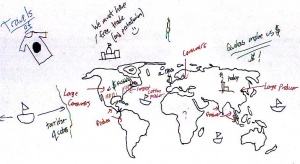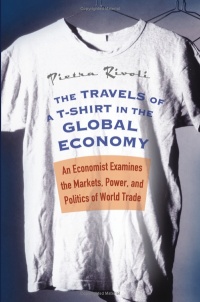World Cultures Portfolio/T-Shirt Trade
From ThePlaz.com
World Cultures Report about Global T-Shirt Industry from The Travels of a T-Shirt in the Global Economy: An Economist Examines the Markets, Power, and Politics of World Trade by Pietra Rivoli (Amazon)
- See also my Book Report
- Guidelines
Africa: HDI Graph Reflections - Decolonization Report
Middle East: Population Density Report - Essay: A Peaceful Vacation
South Asia: Rainfall Report - South Asia Comparisons Graph - Postcards
China: Sphere of Influences Report - Mao Button Journal
Japan: Natural Resources Report - Japanese Violence Journal
Korea: Physical Map Report
Latin America: Landforms Report
Worldwide: T-Shirt Trade Report
The Travels of a T-Shirt in the Global Economy: An Economist Examines the Markets, Power, and Politics of World Trade explains the story (and politics) behind what it takes to produce a T-shirt to sell in America. The highly-complex system involves many people in many countries all working together to make a simple T-shirt which we can buy for only a few dollars.
After observing an anti-globalization protest in 1999, the author set out to find out if what these protesters said held true. The author, a collage professor at Georgetown University then set off to discover what went into a T-shirt. What she discovered held true to her theory, generally accepted by most economists, that globalization has helped us. Many poor countries like Taiwan and Japan have become much better off and now it helps China and India. But a T-shirt, both today and in the past, finds itself affected by creative maneuvers to avoid markets, not embrace them. The author finds that in every step of a T-shirt's life governments have attempted to regulate the textile industry, and prevent competitive markets.
A T-shirt starts its life as cotton grown in Texas. As farmers moved to Texas, tractors first became popular replacing the old producers in the south who relied on slave labor and did not adopt the tractors. Today, cotton farming requires almost no labor, only highly-specialized machines. In addition, universities and the Department of Agriculture research ideas which help our farmers. The developing world can not compete with the private-public partnership and mechanization. In addition, today the farmers own the plants which process, pack, and ship cotton. They band together in cooperatives to make sure their voice gets heard and that the profits go to them. Also a computer analyzes each bushel of cotton and places it onto an electronic sales system which connects the grower directly to the buyer. Developing nations do not have this exacting sales system. Lastly the government provides billions of dollars in subsidies to both cotton growers and buyers. Growers face no risk of bad weather because they know that the US government will subsidies them in the case of crop loss.
In China, the state-run factories must now cope with producing for a market not a state quota. The managers must worry about quality as well as quantity. No longer can they just focus on producing Mao-style jackets, they must produce different styles of cloth and sell them. In addition, the workers crowded inside the Chinese factories choose working under "sweatshop" conditions over the harsh life of working on a farm where one must work hard and in many cases deal with an abusive father. They enjoy the bit of independence they do have; no longer must they directly honor their father's wishes. In addition, they do not need to stand out in the sun all day and get up each day at 3 AM to harvest crops.
However on the T-shirt's trip back to America the shirt encounters a mess of tariffs and quotas. Despite promising free trade, the politicians have developed thousands upon thousands of laws regarding textile imports. However, the power of the textile lobby wanes today. Domestically the industry has shrunken and has become less powerful. However, sometimes the lobby groups join together but soon break up due to bickering. (Ex: The weaving industry wants protection from foreign cloth but a free market for thread. The thread industry, however wants protection for its product but a free market for its suppliers. etc, etc.) But some of the rules still exist today and get very complex for the importers. Due to the many agreements, each country has its own rules with America. It's a mess. And then, every product has its own rules. Furthermore, different rules then apply depending on the source of each component. any times the imports ignore the tariff exemptions because it's easier to just pay the tariff. However this system has helped some developing countries. Producers constantly move around factories to locations with the least rules. Thus factories exist in nations with little tariffs. However, when the rules change again, the factories close and move elsewhere. This puts the workers out of work again.
When she finishes with her shirt, it finally encounters a free market in the highly competitive fabric recycling industry. Charities which receive donated clothing first sort out the stuff they think they can sell in their stores. Then they sell the rest to a processor for about 10 cents a pound. He then sorts the clothing into over 300 different categories. He sells what he can to many different buyers. For example he sells "distressed" jeans to expensive shops which then resell them for hundreds of dollars as special items. The sorter needs an eye for details. For example: old tye-dye = good, old sports jerseys = bad. Then much of the leftover gets shipped to Africa. However not all of it does. African consumers pick through the cloths carefully. They will not buy ripped items and Micky Mouse shirts can fetch 10 times the price of a family reunion shirt. So knowing customers represents the key in this free market of textile recycling.
So in the end the author has discovered T-shirts have more to do with un-free markets. The author believes that we should give everybody a voice in a free market. However to the activist she says continue to keep watch. The activists made life better in the US and Britain years ago. By continuing to demand cloth not made in sweatshops we can continue to make life better for foreigners. But to just protect domestic producers and to assume what employees want, that has failed time and time again. Times do change and our markets do move towards freedom and proving a better life for all. A single t-shirt touches many people and affects so much in the world.
Sources
- Rivoli, Pietra. The Travels of a T-Shirt in the Global Economy: An Economist Examines the Markets, Power, and Politics of World Trade. Hoboken: Wiley, 2005.




